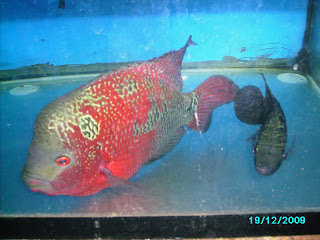Knowing how to sex a flowerhorn is one of the most frequently asked question by someone who wants to venture in either keeping a flowerhorn or somebody who wants to eventually go to breeding of flowerhorn. More often than not a newbie sets out to buy a flowerhorn hoping to get a highly potential flowerhorn male fry but ends up getting a female. Males are more sought after because of the potential of forming big koks and because they grow bigger and have more vibrant color. While females are more often than not culled and disposed of because they have features that are not sought after by buyers. Top females of the school will either be not for sale or will command a higher price if the breeder decides to sell it.
Here are the different ways of sexing your flowerhorn.
1. Difference in body shape and size.
Male flowerhorns are bigger than female flowerhorn. If you are selecting from a community of frys choose the bigger or biggest fry because the males are more dominant than females and stronger so they always have access to food which makes them grow bigger fast.
2.Difference in KOK size
Male flowerhorn will have bigger koks than female flowerhorn.
3.Presence of black markings on dorsal fins.
Female flowerhorn will have black markings on the dorsal fins. These black markings will be evident even in fry as big as 2-3inches. It is accurate way of sexing 80% of the time.
5.Difference in body color.
Female flowerhorn will change in color when breeding time comes while the male maintains its vibrant color.
6. Difference of shape of vent area.
You can differentiate the sex of your flowerhorn by venting.

7.And lastly and most sure fire way of determining if your flowerhorn is male or female.
EGGS
Here are the different ways of sexing your flowerhorn.
1. Difference in body shape and size.
Male flowerhorns are bigger than female flowerhorn. If you are selecting from a community of frys choose the bigger or biggest fry because the males are more dominant than females and stronger so they always have access to food which makes them grow bigger fast.
female flowerhorn
male flowerhorn Emperor by Master Norman
Fagioli mating Notice obvious difference in size between male and female flowerhorn.
Male flowerhorn will have bigger koks than female flowerhorn.
Male flowerhorn with nice big hump.
Female flowerhorn ($600) rare big head female by Mickkamfa commands a high price.
Female flowerhorn with small kok. More common find.
3.Presence of black markings on dorsal fins.
Female flowerhorn will have black markings on the dorsal fins. These black markings will be evident even in fry as big as 2-3inches. It is accurate way of sexing 80% of the time.
My Thaizz from Rainnybetta with black markings on dorsal fins. Below is a female flowerhorn with prominent black marking.
4.Difference in body deportment or posture.
Female flowerhorn will have particular body deportment or body posture.
Some nice looking females. Notice the body shape, small kok and the shape of the fins when they are at a standstill. Female fry aside from being small will project this particular deporment.
5.Difference in body color.
Female flowerhorn will change in color when breeding time comes while the male maintains its vibrant color.
Female flowerhorn by Iceman4242 notice presence of vertical black stripes on body.
Same female after laying eggs. Notice how her body had turned black.
My female kamalau from rainnybetta. She had better color then but as she is nearing her first egg laying her color changed to dark green black color.
My experimental pairing. Chose the male due to its bright red color. Small kok because its a mix kamfazz. Hopefully these pair will produce monsters. If not i just cull the frys and experiment on another pair.
6. Difference of shape of vent area.
You can differentiate the sex of your flowerhorn by venting.
Male reproductive organs will appear in a more shape manner. The tip of the v is pointed towards the anal fins. While the vent is situated between the arms of the v. You can gently squeeze on the vent area and if you notice squirting out of the vents then the fish that you have is a male. Similarly females will have a more u shaped structure at the vent area no fluid will squirt out of the vent when you squeez the vent area.

7.And lastly and most sure fire way of determining if your flowerhorn is male or female.
EGGS
Female lay eggs as early as 3-4inches in size.























































